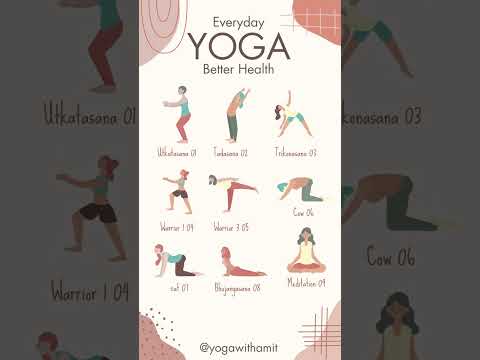Enhancing Your Health Through Yoga Practice: A Comprehensive Guide
Yoga has been celebrated for centuries as a path to holistic well-being, blending physical strength, mental clarity, and emotional balance. In this guide, we’ll explore how practicing yoga can significantly improve health, from a historical overview to its modern applications and potential future implications. Whether you’re a seasoned yogi or a complete beginner, this article aims to provide a thorough understanding of yoga’s benefits, backed by research, case studies, and actionable tips.
Introduction
Yoga is more than a set of physical postures. It is a comprehensive practice that integrates mind, body, and spirit, aimed at enhancing overall well-being. This article will cover essential concepts of yoga, explore its historical roots, examine the current state of yoga in modern health practices, and provide practical applications for various health goals. Through a combination of expert opinions, stakeholder perspectives, and actionable guidelines, this guide will offer a balanced and accessible view of yoga’s profound impact on health.
Key Concepts
Yoga is grounded in the principle of union, aiming to harmonize the physical, mental, and spiritual aspects of an individual. Below are some of the core components:
- Asanas (Postures): Physical exercises designed to enhance flexibility, strength, and balance.
- Pranayama (Breathing Techniques): Controlled breathing exercises to manage energy and stress.
- Meditation: Practices aimed at cultivating mindfulness and mental clarity.
- Yamas & Niyamas (Ethical Guidelines): Principles guiding ethical behavior and self-discipline.
- Chakras: Energy centers in the body, believed to influence various physical and psychological functions.
Historical Context
Yoga’s history spans over 5,000 years, evolving from its roots in ancient India to a globally recognized practice today. Below is a timeline of key developments in yoga’s history:
| Era | Key Developments |
|---|---|
| Pre-Vedic (3000-1500 BCE) | Origins of yoga traced to ancient Indus Valley civilization, with evidence of meditation and physical postures. |
| Vedic Period (1500-500 BCE) | First references to yoga in sacred texts (Rig Veda), focus on rituals and meditative practices. |
| Upanishads & Classical Period (500 BCE – 200 CE) | Development of philosophical foundations; Patanjali’s “Yoga Sutras” formalize Ashtanga Yoga (Eight-Limb Path). |
| Medieval Period (800-1700 CE) | Rise of Hatha Yoga; emphasis on physical postures and breathing techniques. |
| Modern Period (1800-Present) | Yoga introduced to the West; popularization as a holistic health practice and integration with modern medicine. |
Current State Analysis
Today, yoga is practiced by millions worldwide, with a focus on both physical and mental health benefits. Studies have shown that yoga can reduce stress, improve flexibility, enhance cardiovascular health, and aid in managing chronic conditions like anxiety and depression. Below are some current trends and their impact:
- Integration with Physical Therapy: Many physical therapists incorporate yoga into recovery programs for injuries and chronic pain management.
- Mental Health Support: Yoga’s role in cognitive therapy is expanding, with growing evidence of its benefits for anxiety and PTSD.
- Corporate Wellness Programs: Companies are investing in yoga classes to boost employee well-being and productivity.
- Tech-Enhanced Yoga: The rise of apps and online classes has made yoga more accessible, though it raises questions about the quality of instruction.
Practical Applications
Yoga can be tailored to meet various health objectives. Below are some actionable guidelines for specific health goals:
- For Stress Relief: Focus on Restorative Yoga and Pranayama. Use gentle postures like Child’s Pose and deep breathing techniques like Nadi Shodhana (Alternate Nostril Breathing).
- For Strength Building: Incorporate Ashtanga Yoga or Power Yoga for full-body workouts, including poses like Warrior I & II and Plank Pose.
- For Flexibility: Use Vinyasa Flow sequences, focusing on Downward-Facing Dog and Seated Forward Bend.
- For Cardiovascular Health: Try Dynamic Yoga styles like Bikram or Vinyasa, which involve continuous movement and controlled breathing.
- For Better Sleep: Engage in evening yoga practices with Yin Yoga, emphasizing long-held, gentle stretches like Reclined Bound Angle.
Case Studies
Below are real-world examples demonstrating yoga’s impact on various health conditions:
| Case Study | Description | Outcome |
|---|---|---|
| Yoga for Chronic Back Pain | Patients with lower back pain participated in a 12-week Iyengar Yoga program. | Reported a 60% decrease in pain and 40% improvement in flexibility. |
| Yoga for Hypertension | Group of hypertensive patients engaged in Hatha Yoga three times a week for 6 months. | Experienced an average blood pressure drop of 10 mm Hg. |
| Yoga for Anxiety | Individuals with generalized anxiety disorder practiced mindfulness-based yoga for 8 weeks. | Showed a 50% reduction in anxiety symptoms and enhanced overall well-being. |
Stakeholder Analysis
Different groups have a vested interest in the practice and promotion of yoga. Here are some key stakeholders:
- Healthcare Providers: Advocating for yoga as a complementary therapy for various physical and mental health conditions.
- Corporate Employers: Integrating yoga programs to enhance employee productivity and reduce healthcare costs.
- Yoga Studios & Instructors: Promoting traditional and modern forms of yoga as a business and cultural practice.
- Insurance Companies: Exploring yoga’s cost-effectiveness in preventive healthcare.
- Government & Public Health Bodies: Assessing yoga’s role in national health initiatives and community wellness.
Implementation Guidelines
For those interested in incorporating yoga into their routine, here are some general guidelines:
- Choose the Right Style: Select a yoga style that aligns with your health goals. Beginners may start with Hatha Yoga, while those seeking a rigorous workout might choose Ashtanga or Power Yoga.
- Find a Qualified Instructor: Look for certified instructors with experience in your chosen style, particularly if you have health conditions that need special attention.
- Create a Consistent Routine: Aim to practice yoga at least 2-3 times a week, gradually increasing intensity as your fitness improves.
- Focus on Alignment: Proper posture is crucial to avoid injuries. Start with beginner classes to learn the basics.
- Monitor Progress: Keep track of improvements in flexibility, strength, and mental clarity to stay motivated.
Ethical Considerations
The global spread of yoga raises several ethical questions:
- Cultural Appropriation: Debate exists over the Western commercialization of yoga, potentially diluting its spiritual essence.
- Accessibility: Yoga classes can be expensive, limiting access for lower-income individuals.
- Instructor Qualifications: With the rise of online yoga, questions arise about the quality of instruction and the safety of unsupervised practice.
Limitations and Future Research
While yoga has demonstrated numerous health benefits, more research is needed in specific areas:
- Long-term Impact: Few studies track the effects of yoga over decades, particularly for chronic disease prevention.
- Diverse Populations: More research is required to assess the impact of yoga across different demographics, including age, ethnicity, and physical ability.
- Quality of Online Instruction: As digital platforms proliferate, understanding how online classes compare to in-person instruction is crucial.
Expert Commentary
As yoga continues to evolve and integrate with modern health practices, experts emphasize the importance of staying connected to its roots while embracing innovation. A holistic approach to yoga can bring about profound changes in personal health and well-being, but it requires a balance of tradition and modernity, accessibility, and quality instruction. Practitioners are encouraged to remain informed, seek credible guidance, and continually adapt their practice to their changing needs.








